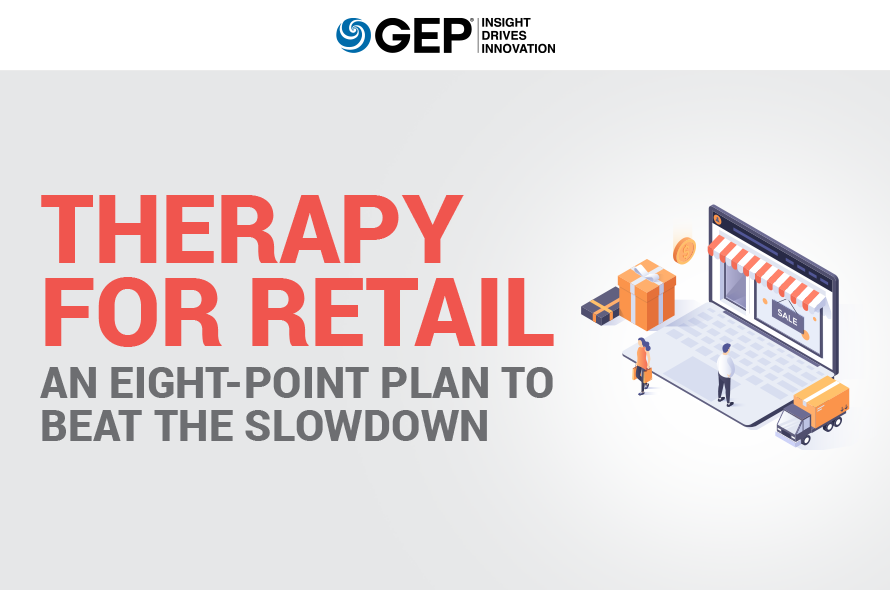Disruption is not new to retail. But the COVID-19 pandemic has added multiple layers of complexity and risk. Consumers are under stay-at-home orders. Discretionary spending has dried up.
GEP’s latest bulletin, Therapy for Retail: An Eight-Point Plan to Beat the Slowdown, offers a way forward: Plan for short-term economic disruption and prepare for recovery with sustainable cost-reduction and supply continuity strategies — while staying engaged with customers.
What’s Inside:
- How procurement can work with suppliers to deliver savings
- Why Budget-to-Pay is an effective cost-saving solution
- Reactions to avoid during this crisis
It’s a must-read for forward-looking business leaders who want to boost cash flows and ready their companies to manage disruptions in the future.
THE RIDE JUST GOT TOUGHER FOR RETAIL
It’s been a difficult few years for retail. Amazon has been hurting sales and margins across multiple segments in the industry. Retailers have fought back by investing heavily in e-commerce capabilities and by continually improving and building their fulfillment capabilities. Winners in this space are limited in number — large, strongly branded companies such as Walmart and Target and a collection of niche providers such as Huckberry and Stitch Fix. Large department chains such as Macy’s, Sears and even Nordstrom have been struggling.
The COVID-19 crisis has added yet another layer of complexity and risk that retailers must now address. The pandemic has impacted this industry on the supply and the demand sides. While the impact on the supply base is known — given the industry’s dependence on Asia-based manufacturing — there has been an equally big impact on revenue. The multi-country lockdowns and global mandates on social distancing and remote working have led to malls and stores downing shutters, and where they are open, foot traffic is severely affected. No retailer remains unscathed, and even luxury retailers such as Estée Lauder are seeing an effect on their top line.
The economic impact of the coronavirus — the looming threat of job losses and recession — has further dampened people’s interest in discretionary spending.
EIGHT STEPS RETAILERS SHOULD TAKE
Reprioritize and Refocus: Conserve cash by halting all capital-intensive projects. Reassess broader transformation programs and focus on activities that increase organizational efficiency and drive savings, which will help in managing the business impact of the coronavirus. For example, targeted demand management projects will help cut costs to balance the ongoing pressures on the top line.
Implement Rapid Sourcing Initiatives: A rapid sourcing program focused on cost takeout through negotiations and not RFPs can deliver savings to the organization in the near term. A team of procurement professionals supported by a CEO mandate can deliver value quickly.
Work Strategically with Suppliers: Segment your supply base and work with tier 1 suppliers through a supplier management program to improve payment terms, increase product substitution, and other ways to jointly share the cost burden. Remember, most suppliers are facing the same demand-related issues.
Reassign Rather Than Reduce: There is no one-size-fits-all solution. While many retailers are dealing with a demand slide, some such as grocery chains are facing challenges caused by a huge surge in demand. In this case, a better solution might be to deprioritize savings and focus on meeting customer needs; grocery chains can use this opportunity to strengthen their brand and reputation.
Understand Supply Chain Risk: The interconnectedness of the supply base can mean a high level of risk. If companies are sharing co-manufacturers, the loss of a key supplier could push the manufacturer out of business. Diversifying would be an option, but contingency plans to manage the coronavirus’ impact on the supply chain should be put in place now, not when the next crisis hits. While onshoring or nearshoring has cost implications, the alternative is much more painful, as we are seeing.
Remember the Customer: Delivery times, out-of-stock items, closed stores — these are all inevitable. Communicating the status on these is key. The approach to engaging with customers is not necessarily a cost solution, but rather a way to gain access to what is proving to be a smaller and tighter share of the wallet. We mentioned “Reprioritize and Refocus” earlier. Part of this includes ongoing engagement with customers, and the opportunity to focus on online vs. brick-and-mortar, on targeted marketing vs. flyers, on private label vs. branded.
Implement Budget-to-Pay Solution: Cost containment and reduction should be sustainable. While there is a tendency to cut costs for the near term (and in some cases, rightly so), over time original behavior patterns will return and costs will rise. Strong policies with leadership support can help mitigate this problem, but a bigger and much more effective approach is to implement Budget to Pay (B2P). B2P is typically a targeted solution that provides clear visibility into spend and ensures budgets are adjusted in real time. This helps address the inevitable “cost creep” that occurs over time.
Consider the Don’ts:
- Don’t slash and burn. Concentrate on efforts to support employees. Short-term furloughs can be extended. While painful, they will reduce the need for mass layoffs, and the accompanying cost to hire in the future.
- Don’t panic and reactively manage on a day-to-day basis; instead, focus on the critical items. Refinance debt, if possible.
- Don’t look only at the near term. Look for ways to institutionalize learnings and make plans for once you are on the other side of this crisis.
DISRUPTION IS THE NEW NORMAL
“We never expected it to be so big,” seems to be a common refrain, but in reality, the supply chain disruption due to coronavirus is not dissimilar to what most retailers have been experiencing for several years now. Managing in disruptive times is the new normal.
To reiterate, we see three broad areas of focus for retail:
- Implement sustainable cost-reduction initiatives through relentless attention to reduction of non-core, or indirect, cost
- Continue to build goodwill and manage relationship with customers through online channels
- Keep an eye on the future, and watch for change in customer spending power
RAPID RESPONSE SOLUTIONS FROM GEP
As the coronavirus crisis intensifies, managing your supply chain is going to get even more challenging. It may be worth finding a partner with deep experience in procurement and supply chain management to reinforce your capabilities and help you stay on course.
If you would like to have a conversation about how we can help, please reach out to our supply chain leadership.

Mukund Acharya
Vice President, Global Delivery
GEP
Mukund has over 20 years of business transformation, procurement and strategy consulting experience at Fortune 500 companies in retail, technology and consumer products industries. He has focused on procurement, supply chain management and top-line growth strategy initiatives, leading cross-functional teams to deliver sustainable value. He has led large, complex global projects in all aspects of procurement and supply chain, including process re-engineering, strategic planning, and system implementation.

